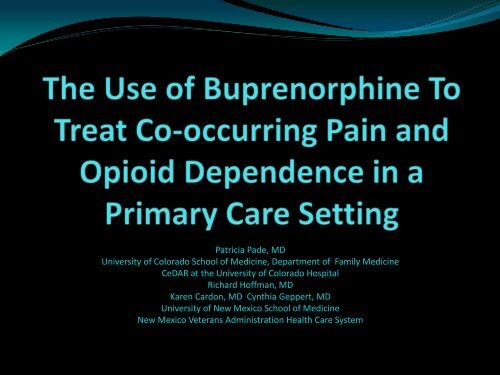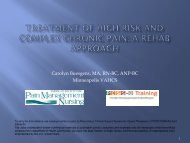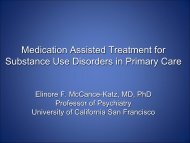View Presentation Slides - PCSS-O
View Presentation Slides - PCSS-O
View Presentation Slides - PCSS-O
Create successful ePaper yourself
Turn your PDF publications into a flip-book with our unique Google optimized e-Paper software.
Patricia Pade, MD<br />
University of Colorado School of Medicine, Department of Family Medicine<br />
CeDAR at the University of Colorado Hospital<br />
Richard Hoffman, MD<br />
Karen Cardon, MD Cynthia Geppert, MD<br />
University of New Mexico School of Medicine<br />
New Mexico Veterans Administration Health Care System
Disclosures<br />
• No Conflict of Interest to disclose<br />
• The reported data is a clinical quality improvement<br />
project performed at the New Mexico VA Health Care<br />
System.
Objectives<br />
• To provide a brief overview of the epidemiology and<br />
prevalence of chronic pain and opioid dependence and<br />
increasing overdose rates and fatalities along with<br />
pharmacology of buprenorphine.<br />
• To review and analyze data from a clinic integrating<br />
primary care pain management and opioid dependence to<br />
evaluate effectiveness of buprenorphine therapy.<br />
• To describe the induction process and utilization of<br />
buprenorphine in the treatment of pain and opioid<br />
dependence in an outpatient setting along with the<br />
monitoring process to assess efficacy.
Epidemiology
Chronic Pain<br />
• 116 million people in the US suffer with chronic pain –<br />
which is more than diabetes, cancer and heart disease<br />
combined 1<br />
• 35% American adults experience chronic pain<br />
• Annual health care costs – expenses, lost wages,<br />
productivity loss estimated to be $635 billion 1
Prescriptions (millions)<br />
Steady Increases in Opioid Prescriptions<br />
Dispensed by U.S. Retail Pharmacies,<br />
1991-2011<br />
250<br />
Opioids Hydrocodone Oxycodone<br />
200<br />
150<br />
100<br />
76 78 80<br />
86<br />
91<br />
96<br />
100<br />
109<br />
120<br />
131<br />
139<br />
144<br />
151<br />
158<br />
169<br />
180<br />
192<br />
201 202<br />
210<br />
219<br />
50<br />
0<br />
IMS’s Source Prescription Audit (SPA) & Vector One®: National (VONA)
Opioid Use<br />
• Use of opioids has increased substantially over the past<br />
20 years despite limited evidence for efficacy in chronic<br />
noncancer pain 3,4<br />
• Rise in opioids utilization corresponds to rise in opioid<br />
abuse and dependence – rates of opioid misuse<br />
(includes abuse and dependence as well as recreational<br />
use) estimated between 18 to 41% 5 and aberrant<br />
medication behavior as high as 50% 6
Abuse of Prescription Opioids<br />
• 7 million Americans (2.5% of the population) over the age<br />
of 12 admit to misuse of prescription psychotherapeutic<br />
medications<br />
• 1.9 million prescription narcotic users meet diagnostic<br />
criteria for opioid abuse or dependence (second only to<br />
marijuana, 4.3 million)<br />
• New users of prescription opioids are about the same as<br />
that of marijuana (National Survey on Drug Use and<br />
Health, 2010)
Fatal Drug Poisoning<br />
• Between 1999 and 2002, the number of opioid analgesic<br />
poisonings on death certificates rose 91.2%<br />
• During this time period, poisoning from methadone<br />
surpassed both cocaine and heroin poisoning as the most<br />
frequent type of drug poisoning found on death certificates<br />
in the U.S.<br />
• New Mexico led the country in overdose deaths and one of<br />
the higher rates of nonmedical use of prescription opioids.<br />
CDC MMWR Nov 4, 2011 60(43) 1487-1492<br />
Paulozzi, L.J., Budnitz, D.S., Xi, Y, 2006. Increasing deaths from opioid analgesics in the United States. Pharmacoedidemiology and<br />
Drug Safety 15, 613-7.
Deaths per 100,000 population<br />
12<br />
10<br />
8<br />
6<br />
4<br />
2<br />
0<br />
Deaths from Opioid Pain Relievers Exceed Those from Illegal Drugs in<br />
all Age Groups<br />
3.7<br />
2.2<br />
7.1<br />
Opioid pain relievers<br />
4.4<br />
8.3<br />
5.3<br />
15--24 25--34 35--44 45--54 55--64 ≥65<br />
Age Group<br />
Illegal drugs<br />
10.4<br />
6<br />
5<br />
2.5<br />
1<br />
0.3<br />
More Drug Overdose Deaths are Associated with Opioid Pain Relievers than with Illegal Drugs. Data are for 2008. Illegal drug deaths include deaths from overdose of<br />
heroin, cocaine, hallucinogens, or stimulants. Source: CDC, Morbidity and Mortality Weekly Report, 60(43): 1489, 2011.
Opioid Pharmacology:<br />
How do these Medicines Work
Etiology of Opioid Abuse: Neurobiology of Addiction<br />
Cortex<br />
Prefrontal Cortex<br />
NAc<br />
Thalamus<br />
VTA<br />
• Mu opioid receptors distributed widely in the brain.<br />
• While binding in the thalamus produces analgesia, binding in the cortex produces<br />
impaired thinking/balance;<br />
• Ventral tegmental area (VTA)/nucleus accumbens (NAc) is associated with<br />
euphoria that some experience (i.e. the “high”). This area is the reward pathway<br />
• Binding in this reward pathway is believed responsible for reinforcing effect leading<br />
to potentially to addiction.
• Tolerance:<br />
Repeated Dosing:<br />
Opioid Tolerance and Withdrawal<br />
• Need more for same effect<br />
• Less effect with same amount<br />
• Occurs for euphoria, sedation, respiratory depression, vomiting,<br />
analgesia<br />
• Minimal tolerance to constipation, miosis, sweating<br />
• Can attain high levels of tolerance with gradual increases to<br />
doses that would otherwise be lethal<br />
• Withdrawal:<br />
• Upon reduction or cessation of opioid use/administration
DSM-IV Criteria for Opioid Dependence<br />
• The substance is often taken in larger amounts or over a<br />
longer period than was intended<br />
• There is a persistent desire or unsuccessful efforts to<br />
cut down or control substance use<br />
• A great deal of time is spent in activities necessary to<br />
obtain the substance, use the substance, or recover<br />
from its effects<br />
• Important social, occupational, or recreational activities<br />
are given up or reduced because of substance use<br />
• The substance use is continued despite knowledge of<br />
having a persistent or recurrent physical or<br />
psychological problem that is likely to have been caused<br />
or exacerbated by the substance
Brief pharmacology overview:<br />
full opioid agonists<br />
μ<br />
opioid<br />
receptor<br />
μ<br />
receptor<br />
Full agonist<br />
• Full agonist binding activates the μ opioid receptor<br />
• Is highly reinforcing<br />
• Is the most abused opioid type<br />
• Full agonists are: heroin, oxycodone, methadone, and others
Brief pharmacology overview:<br />
partial opioid agonists<br />
μ<br />
opioid<br />
receptor<br />
μ receptor<br />
partial agonist<br />
• Partial agonist binding activates the μ opioid receptor at lower levels<br />
• Is less reinforcing<br />
• Is a less abused opioid type<br />
• Blocks opioid agonist (and antagonist) binding<br />
• Partial agonists include: Buprenorphine
Brief pharmacology overview:<br />
opioid receptor antagonists<br />
μ<br />
opioid<br />
receptor<br />
μ receptor<br />
antagonist<br />
• Antagonist binding to the μ opioid receptor occupies without<br />
activating<br />
• Is not reinforcing<br />
• Blocks abused opioid agonist binding<br />
• Antagonists include: Naloxone and Naltrexone
Buprenorphine’s Unique Properties<br />
• Partial Agonist/Antagonist: has better safety profile – less<br />
respiratory depression<br />
• Highest affinity for the opioid receptor: will replace a pure<br />
agonist and even antagonist off the receptor<br />
• Long half-life – will bind the receptor for long period –<br />
elimination ½ life is ~ 37 hrs.<br />
• Has no oral bioavailability - its use in opioid dependence is<br />
the
The Use of Buprenorphine/Naloxone to treat<br />
opioid dependence<br />
• Buprenorphine/Naloxone:<br />
<br />
<br />
<br />
In 2002, Drug Abuse Treatment Act approved<br />
sublingual formulations of buprenorphine for<br />
treating opioid addiction<br />
Effectively treats opioid addiction by reducing illicit<br />
opioid use, improving treatment retention (55-<br />
60%) 9 , and increasing negative urine toxicology<br />
screens 10<br />
Physicians fulfilling certification requirements can<br />
apply to Center for Substance Abuse Treatment for a<br />
special waiver to prescribe.
Buprenorphine/Naloxone for the<br />
treatment of pain and opioid<br />
dependence<br />
• Must meet DSM-IV opioid dependence criteria<br />
• No contraindications to treatment<br />
• Follow established guidelines for induction and<br />
maintenance<br />
• Buprenorphine efficacy vs opioid agonist such as morphine<br />
is unclear and probably varies with type of pain. In the<br />
Buprenorphine trainings, we teach that buprenorphine has<br />
analgesia 30 X that of morphine. 11 However, to compare<br />
efficacy is difficult.<br />
• Buprenorphine dosed three to four times daily for control<br />
of pain (versus daily in opioid dependence alone).
The Problem for Veterans
Delivery Problems in the Old System<br />
• Providers:<br />
Addiction providers uncomfortable<br />
treating pain<br />
Pain Management providers<br />
uncomfortable treating addiction<br />
PCPs uncomfortable treating both<br />
and PCPs prescribe the opioids<br />
Lack of training of providers in<br />
addiction<br />
Regulations surrounding opioids<br />
Perceive patients as difficult and<br />
time-consuming.<br />
• Patients<br />
Stigmatization to addiction<br />
Believe pain is primary problem not<br />
addiction<br />
Fear their pain will not be addressed<br />
Denial<br />
SUD programmatic treatment is<br />
overwhelming<br />
Not ready for treatment<br />
Many will agree to treatment in<br />
Primary Care but are reluctant to go<br />
to “Bldg. 1.”
Improvement Change:<br />
Creation of Co-occurring Disorders Clinic (CODC)<br />
• Establishment of unique clinic within Ambulatory Care<br />
Service to evaluate, treat, manage and monitor comorbid<br />
pain and addiction:<br />
High risk opioid patients<br />
• history of substance use disorder<br />
• family history of substance use disorder<br />
• younger age<br />
• psychiatric illness<br />
Noncompliant patients<br />
Complex pain regimens<br />
Prescribed high dose opioids
Plan of CODC<br />
• Integrate treatment of co-occurring pain and addiction<br />
Can provide treatment for pain and addiction simultaneously<br />
<br />
Can provide pharmacologic and nonpharmacologic treatments for pain to<br />
minimize opioid use<br />
• Embed the clinic within primary care<br />
CODC providers available for immediate consultation<br />
<br />
<br />
Greater acceptance of pain and addiction as a disease such as medical<br />
conditions<br />
Decreased stigmatization<br />
• Utilize the chronic care model to treat co-occurring pain and<br />
addiction<br />
Versus episodic care that is traditionally offered<br />
• Utilize pharmacotherapy such as Buprenorphine/Naloxone to<br />
treat opioid dependence and pain.
Patient population<br />
• Referrals from primary care providers,<br />
interventional pain management specialists,<br />
internal medicine and surgical specialties.
Referral statistics
Initial<br />
Evaluation<br />
A. PAIN<br />
Detailed history and<br />
comprehensive physical;<br />
detailed pain<br />
Rx/intervention history;<br />
BPI<br />
B. SUBSTANCE ABUSE<br />
Detailed substance history/risk<br />
assessment; DIRE; SOAPP; urine<br />
toxicology; NM prescription<br />
monitoring consent; opioid use<br />
agreement<br />
C. Psychiatric<br />
Detailed psych history<br />
and evaluation<br />
CODC Process<br />
Buprenorphine<br />
/Naloxone<br />
w/ adjuncts and<br />
monitoring<br />
OR<br />
Opioids<br />
w/ adjuncts and<br />
monitoring<br />
Adjunctive<br />
Treatment<br />
TENS unit and training, Psychiatric<br />
treatment, Adjunctive Rx: TCAs,<br />
non-opioid analgesics,<br />
anticonvulsants<br />
Referrals to: interventional pain<br />
clinic, ortho clinic, spine clinic, SUD,<br />
physical therapy, pool therarpy<br />
Clinic follow-up: weekly-monthly<br />
POC urine toxicology, on-going pain<br />
and risk assessment (COMM, BPI)<br />
Ongoing<br />
Monitoring
Pre-induction opioid management<br />
• Recommendations are to stop short acting<br />
opioids 12-24 hrs before starting buprenorphine.<br />
• TIP-40 recommends that patients taper on<br />
methadone to 30mg per day and abstain 36<br />
hours.<br />
• If we are prescribing long acting opioids for pain,<br />
then we will taper to 90 morphine mg<br />
equivalents per day, and first convert to short<br />
acting opioids for 2-4 weeks. We have found the<br />
induction goes far smoother.
Buprenorphine induction process<br />
• If prescribed short acting opioids:<br />
stop 12-24 hrs before induction.<br />
• If prescribed long acting opioids:<br />
will taper to a dose of 90mg of<br />
morphine equivalents then switch to short<br />
acting opioids
Data from the Co-occurring Disorders<br />
Clinic June 2009 to Nov. 2011<br />
Hypothesis: Major barrier to utilizing buprenorphine in<br />
chronic pain patients would be inadequate pain relief.<br />
Few studies utilizing buprenorphine SL in pain and<br />
addiction.<br />
Pade P, Geppert C, Cardon K, Hoffman R, “Co-occurring Disorders Clinic” SAMHSA Science<br />
and Service Award for Office Based Opioid Therapy, Feb 2012.<br />
Pade P, Cardon K, Hoffman R, Geppert C, “Prescription Opioid Abuse, Chronic Pain, and<br />
Primary Care: A Co-Occurring Disorders Clinic in the Chronic Disease Model” JSAT, 43(2012)<br />
446-450.
Study participants<br />
Participant Data<br />
n = 143<br />
Bar graph – drug of choice<br />
90<br />
80<br />
70<br />
60<br />
50<br />
40<br />
30<br />
• Average age: 52<br />
• Age range: 25-74<br />
• Gender:<br />
• M = 133<br />
• F = 10<br />
20<br />
10<br />
0<br />
21-40 41-60 >60
Participant Opioid of Choice (OOC)<br />
16 (11%)<br />
1 (0.6%)<br />
9 (6.3%)<br />
codeine<br />
heroin fentanyl<br />
23 (16%)<br />
methadone<br />
hydrocodone<br />
18 (12.5%)<br />
hydromorphone<br />
oxycodone<br />
1 (0.6%)<br />
63 (44%)<br />
methadone<br />
hydromorphone<br />
heroin<br />
codeine<br />
hydrocodone<br />
oxycodone<br />
fentanyl
Months<br />
Average duration of opioid use<br />
300 255<br />
250<br />
By opioid of choice<br />
200<br />
150<br />
100<br />
121<br />
95 90<br />
84 84<br />
50<br />
0<br />
Opioid of choice<br />
Average: 115 Months<br />
Range: 7-360 Months
Average dose<br />
(morphine mg equivalents/day)<br />
Dosage in morphine mg equivalents/day<br />
350<br />
300<br />
343<br />
By opioid of choice<br />
250<br />
220 218<br />
200<br />
150<br />
100<br />
50<br />
123<br />
106<br />
0<br />
methadone fentanyl morphine oxycodone hydrocodone<br />
Opioid of choice<br />
Average: 184 morphine<br />
mg equivalents/day<br />
Range: 30-1290 morphine<br />
mg equivalents/day
Number<br />
Number<br />
Number<br />
60<br />
40<br />
Co-morbid History<br />
59<br />
38<br />
S.U.D. History<br />
20<br />
17<br />
0<br />
Alcohol Cocaine Marijuana<br />
25<br />
20<br />
15<br />
10<br />
5<br />
23<br />
15 15<br />
9<br />
Medical History<br />
6 5<br />
0<br />
80<br />
60<br />
40<br />
20<br />
0<br />
Hep C D.M. C.A.D. Sleep Apnea C.K.D. Seizures<br />
69<br />
43<br />
Psychological History<br />
16<br />
4<br />
Depression PTSD Anxiety Bipolar
Number<br />
Pain Location<br />
79<br />
80<br />
70<br />
60<br />
50<br />
40<br />
30<br />
20<br />
10<br />
17<br />
13<br />
7<br />
0<br />
Lower Back<br />
Pain<br />
Multiple Joint<br />
Arthritis<br />
Migraines<br />
Fibromyalgia
Adjuvant Medications<br />
Na<br />
and Interventions<br />
N = 143<br />
Antidepressants # NSAIDS # Anticonvulsant<br />
s<br />
# M. Relaxers # Other #<br />
Amitriptyline 3 Celebrex 1 Gabapentin 31 Baclofen 11 Capsaicin 7<br />
Duloxetine 5 Ibuprofen 25 Pregabalin 9 Cyclobenzaprine 7 ESI 3<br />
Nortriptyline 1 Ketoprofen 1 Methocarb. 7 Lidocaine<br />
patch<br />
Paroxetine 6 Meloxicam 4 Tizanidine 2 Intra-art.<br />
injection<br />
Venlafaxine 18 Naproxen 8 TENS 10<br />
Salsalate 1 Pain group 5<br />
TOTALS 33 40 40 27 43<br />
5<br />
13
Buprenorphine dosage for pain<br />
• Mean daily dose: 16 mg of BUP/NLX<br />
Most common regimens:<br />
• 38 patients (26%) – BUP/NLX 8mg/2mg bid<br />
• 28 patients (19%) – BUP/NLX 8mg/2mg tid<br />
• 26 patients(18%) – BUP/NLX 4mg/1mg tid.
Ongoing monitoring for compliance<br />
• Patient compliance with appointments<br />
• Clinical assessment<br />
• Pharmacy records/Clinical record<br />
• Prescription monitoring program<br />
• Urine toxicology screening<br />
- POCT in clinic: opiates, THC, Cocaine,<br />
benzos, barbiturates,<br />
oxycodone, Bup, amp<br />
• Collateral from significant others
Outcomes<br />
Outcomes: 65% of participants<br />
are still active in the program<br />
Off opioids 14%<br />
Discontinued 21%<br />
Outcomes: pain scores before<br />
and during buprenorphine<br />
treatment<br />
BEFORE<br />
Mean score:<br />
6.39 (95% CL 6.2, 6.6)<br />
DURING<br />
Mean score:<br />
5.6 (95% CL 5.4, 5.8)<br />
Active on BUP 65%<br />
Pain scores DECREASED after<br />
buprenorphine treatment. This<br />
difference is statistically significant.
93/143 patients remained in<br />
treatment – 65%<br />
Length of time in treatment<br />
6%<br />
7%<br />
21% - >12 months<br />
65% - > 6 months<br />
< 6 months<br />
> 6 months<br />
> 12 months<br />
> 18 months
Reasons for discontinuing
Conclusions<br />
11. Patients with co-occurring chronic pain and<br />
opioid dependence can be successfully treated in a<br />
primary care setting.<br />
2. Buprenorphine/Naloxone can successfully be<br />
utilized in conjunction with adjunctive treatments<br />
available to primary care providers to treat cooccurring<br />
chronic pain and opioid dependence.<br />
3. Patients with co-occurring chronic pain and<br />
opioid dependence showed improved pain scores<br />
utilizing Buprenorphine/Naloxone treatment.
Solution: The Force Multiplier<br />
Began in August 2011<br />
Utilizes tele-medicine to train primary care providers to deliver<br />
specialty care<br />
Utilizes case-based training and didactic sessions to increase<br />
proficiency and confidence of primary care providers in their<br />
management of complex cases
Office Based Opioid Treatment:<br />
Buprenorphine Training<br />
• March 7, 2012: conducted the first SCAN OBOT<br />
training held at the VA<br />
• 52 attended; 8 hour session enabled physicians to<br />
apply for a DATA 2000 waiver to prescribe<br />
Buprenorphine for the treatment of opioid<br />
dependence<br />
• 23 submitted applications<br />
• Physician waivers:<br />
– Year 1: prescribe for 30 patients at one time<br />
– After year 1: up to 100 patients at one time
The authors wish to thank the following<br />
individuals for their dedication to the<br />
patients in CODC and the clinic<br />
• Barbara Grover, RN<br />
• Kristin Harrison, RN<br />
• Charlene Angus, LPN<br />
• Harriet Hill, RN<br />
• Cassandra Duran, RN<br />
• Rebecca Gutierrez<br />
• Leslie Johns<br />
• Pedro Lugo<br />
• Martin Schimmel, MD<br />
Many thanks to Laura Martin, MD for her assistance<br />
with this presentation.
References<br />
1. Institute of Medicine(IOM), Relieving Pain in America: A Blueprint for Transforming Prevention, Care,<br />
Education and Research. The National Academies Press 2011 Washington DC.<br />
2. Clark JD. Chronic pain prevalence and analgesic prescribing in a general medical population. J Pain Symptom<br />
Manage 2002;23:131-7.<br />
3. IMS’s Source Prescription Audit (SPA) & Vector One®: National (VONA)<br />
4. Chabal, C., M. K. Erjavec, et al. (1997). "Prescription opiate abuse in chronic pain patients: clinical criteria,<br />
incidence, and predictors." Clin J Pain 13(2): 150-155.<br />
5. Caudill-Slosberg MA, Schwartz LM, Woloshin S. Office visits and analgesic prescriptions for musculoskeletal<br />
pain in US: 1980 vs. 2000. Pain 2004;109:514-9.<br />
6. The SUD-QUERI Executive Committee, "Improving Access to Opioid Agonist Therapy,", QUERI Update, VA<br />
Office of Research and Development and HSR&D Quality Enhancement Research Initiative, June 2012.<br />
7. Bohnert M, Valenstein M, Bair M, Ganoczy D, McCarthy J, Ilgen M, Blow F. Association between opioid<br />
prescribing patterns and opioid overdose-related deaths. JAMA 2011;305(13):1315-1321.<br />
8. Web-based Injury Statistics Query and Reporting System: leading causes of death reports. Centers for Disease<br />
Control and Prevention. http://www.cdc.gov/injury/wisqars/index.html.<br />
9. Fudala PJ, Bridge TP, Herbert S, et al. Office-based treatment of opiate addiction with a sublingual-tablet<br />
formulation of buprenorphine and naloxone. N Engl J Med 2003;349:949-58.<br />
10. O'Connor PG, Oliveto AH, Shi JM, et al. A randomized trial of buprenorphine maintenance for heroin<br />
dependence in primary care clinic for substance users versus a methadone clinic. Am J Med 1998;105:100-5.<br />
11. Johnson RE, Fudala PJ, Payne R. Buprenorphine: considerations for pain management. J Pain Symptom<br />
Manage 2005;29:297-326.





